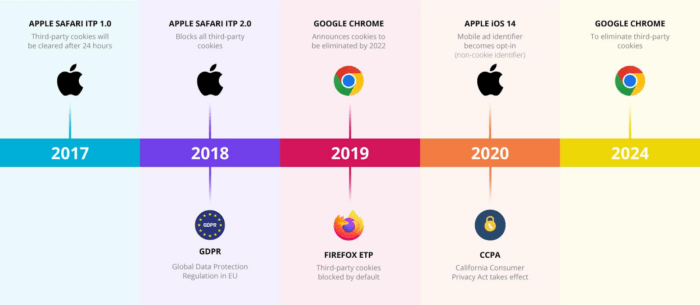Navigating the New Era: Digital Marketing Trends in 2024
As a digital marketing professional and self-professed technology nerd, one of the things I love most about this industry is the constant changes in technology. There is always something new to test and try and features of digital ad platforms are always evolving.

Image credit – OpenAI/DALL-E
If I had to sum 2023 up with one word, it would be AI. Everything was about AI and machine learning in 2023 (at least as far as the mainstream news goes). Digital platforms like Google and Meta have been leveraging machine learning and AI for years now with various smart bidding campaign types. Third-party platforms like Marin have been using machine learning for smart bidding for over a decade and Vovia has been leveraging tools like this for years before AI and machine learning became the buzzwords they are today.
There is no doubt that ongoing advancements in AI and machine learning will continue to be the headline trend in 2024, offering new ways to improve efficiency and results, and offering up new tools and features, but I think that in the area of Digital Marketing specifically, one defining trend will emerge… the growth in adoption of organizations leveraging first-party or owned data in digital campaigns.
You see, 2024 marks one of the most significant transformations in the history of Digital Marketing. This transformation is being driven by Google’s decision to remove third-party cookie support from its Chrome browser. In this post, we aim to delve into this monumental shift, and its implications and explore how businesses can adapt and thrive in a changing digital world.
The End of Third-Party Cookies in Chrome
For years, third-party cookies have been the cornerstone of digital marketing, enabling advertisers to track user behaviour across the web and deliver targeted ads. However, this practice has raised concerns regarding user privacy and data protection.
Privacy legislation like the GDPR and CCPA acted as a catalyst for competitor browsers Safari (Apple) and Firefox (Mozilla) to start the process of ending third-party support way back in 2017. Google has long been the holdout with its Chrome browser. This change was originally supposed to occur in 2022, but Google failed to meet that deadline as they were still refining their plan for dealing with the loss of third-party cookie support. 2024 marks the year when Google will finally phase out third-party cookies. In fact, starting January 4, 2024 Google began pulling support of third-party cookies for 1% of Chrome users and will gradually increase this throughout the year.

Image Credit: https://dataeq.com/news/the-cookie-apocalypse-end-of-third-party-cookies/
Make no mistake, this policy change is monumental. Chrome’s vast user base consisting of over 2.5 billion users means the impact will be felt across the entire digital advertising ecosystem. The removal of third-party cookies from Chrome signifies a significant shift away from the traditional methods of tracking and targeting consumers, compelling marketers to rethink their digital strategies.
Third-party cookies have long been a staple in tracking user journeys across the web, aiding in personalizing experiences and measuring the effectiveness of marketing campaigns. Their removal has challenged advertisers to find new ways to gather insights and reach audiences.
As we move towards a cookieless future, businesses must understand these changes and prepare for the shifting landscape of digital marketing.
The Rising Importance of First-Party Data
In the wake of third-party cookies’ departure, first-party data has emerged as the new gold standard in Digital Marketing. Unlike third-party data, which is collected by external organizations, first-party data is gathered directly by your business through interactions with your customers. This data includes information from website visits, purchases, customer feedback, email campaigns and social media engagement.
First-party data is invaluable because it’s both highly relevant and specific to your business. It offers deeper insights into customer behaviour, preferences, and needs, allowing for more personalized and effective marketing strategies. Moreover, because this data is collected with direct customer interaction, it’s seen as more trustworthy and less intrusive, aligning with growing concerns about privacy and data protection.
The benefits of leveraging first-party data in marketing campaigns are numerous:
- Enhanced Personalization: Tailor your marketing efforts based on specific customer interests and behaviours, resulting in more effective and engaging campaigns.
- Improved Customer Insights: Gain a deeper understanding of your audience, enabling better decision-making and more targeted messaging.
- Increased Customer Loyalty: By using data to improve customer experience, you foster loyalty and long-term relationships.
- Data Privacy Compliance: First-party data collection is generally more compliant with privacy regulations, reducing legal risks. You can fairly easily document consent through the use of consent management platforms.
- As businesses shift towards a first-party data strategy, the emphasis is on creating meaningful interactions and experiences that encourage customers to share their information willingly. This transition presents an opportunity to build stronger, more direct relationships with customers, laying a foundation for sustainable growth in the digital marketing space.
Top Steps Organizations Can Take to Adapt to the Removal of Third-Party Cookies
- Diversifying Digital Marketing Strategies
Moving away from third-party data reliance means exploring new avenues. Diversification is key. Consider expanding into content marketing, email campaigns, and social media engagement. Utilize platforms like YouTube and TikTok, which are gaining traction among users, to reach a broader audience.
- Investing in First-Party Data Collection
The importance of first-party data cannot be overstated. Optimize your digital platforms (CRM, Website, Marketing Automation etc.) to effectively collect and manage this data. This includes enhancing website user experience to encourage sign-ups, subscriptions, and customer interaction, leading to valuable data collection.
- Exploring Alternative Tracking Technologies
Research and invest in new technologies and methodologies that don’t rely on third-party cookies. Consider adopting solutions like Google’s enhanced conversions and the Meta conversion API which offer different approaches to user tracking and data collection while respecting privacy.
- Leveraging AI and Machine Learning
Artificial Intelligence and Machine Learning can analyze large sets of first-party data to derive valuable customer insights and predict behaviours. These technologies can help compensate for the loss of granular data from third-party cookies. Vovia just so happens to have an amazing Marketing Intelligence team that loves to do this kind of work.
- Enhancing User Privacy and Trust
Transparency in data collection and adherence to privacy regulations is essential. Update privacy policies and be open about your data use practices. Adopt a consent management platform (CMP) to get ahead of legislation that will eventually require it in Canada and the US. Building trust with your audience is not just a strategy; it’s a core value that strengthens customer relationships.
The transition to a post-third-party cookie world is an opportunity for businesses to innovate and develop more direct, meaningful relationships with their customers. By adopting these strategies, businesses can not only adapt but also find new ways to excel in the digital marketing arena.
